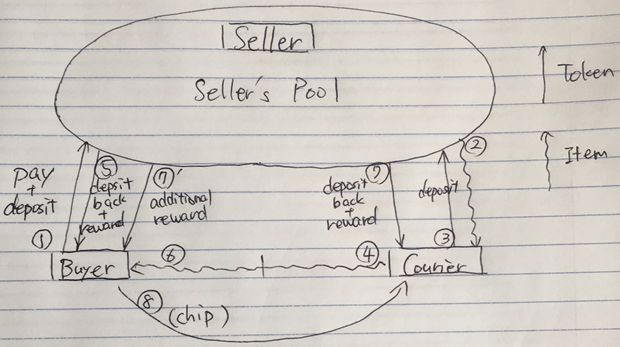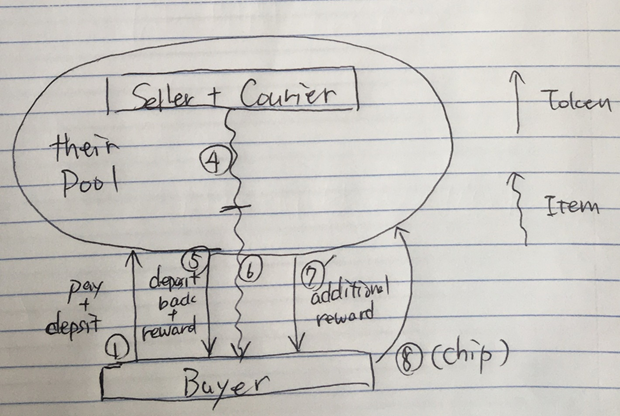


1. Approach
1.1. Overview: Token economy to solve the problem of redelivery
A large amount of redelivery causes Japan to waste time and money. In order to tackle this problem, we would like to use the model of “token economy” to the logistic industry. Token economy is one of the business models using Blockchain where those who perform specific activity recommended by token distributors can get tokens as rewards.
1.2. Problem
· In Japan, about 20% of courier items are redelivered[3].
· Redelivery causes annual social costs in Japan of about 420,000 tons of CO2 emissions and consumes about 180 million hours of driver’s time[3].
Remark:
Figure 1 shows the conventional 3-body delivery model. As we can see, there is no action taken by Buyer after payment(shown in ①, Figure 1) until items delivered because they do not have to take care. This cause Buyer not to feel responsible to receiving items. Hence, many Buyer are not at the destination of items when they are supposed to be.
This economy is comprised of three stake holders: buyers (consumers), couriers (logistic company) and sellers (market holders).

1.3. Economy and design of tokens
This report proposes the new delivery model. This economy is comprised of three stake holders: buyers (consumers), couriers (logistic company / local driver) and sellers (market holders).
-Token Distributor: sellers; sellers deposit some tokens as a pool
-Recommended activity:
· For couriers, delivering items on time
· For buyers, answering to the notification of delivery whether they are at delivery destination (home, office and so on) or not and being there on time
-Reward: token
-Uses of token: one of the currencies in the market
Figure 2 shows the new 3-body delivery model.

-Model Detail:
① Buyer pays and deposits to the pool.
② Seller sends the items to Courier.
③ Courier deposits to pool.
④ Courier starts to deliver.
When Courier comes close to 3km away from each delivery destination, Buyer receives notification saying like “Your delivery will arrive within 30 minutes.” This message automatically sends from Courier’s tablet.
⑤ If Buyer replies the information whether his current location is delivery destination or not, regardless the answer, he gets back deposit and gets a random amount of reward. If Buyer doesn’t send back, he loses very little amount of their tokens and these are sent to pool.
⑥ Either if Courier get reply telling Buyer is at the destination or he doesn’t get any reply, the items should be delivered to the destination.
⑥’ If Courier get reply that tells Buyer is out of the destination, the items are not delivered.
⑦ If Courier delivers on time, he gets back deposit and gets a random amount of reward.
⑦’ If Buyer is at the delivery destination and receives the items at that time, he gets an additional random amount of reward.
⑧ If Buyer wants to express gratitude for Courier, he can send arbitral amount of chip.
Remark:
As shown in Figure 3, the new 2-body delivery model can be easily derived by merging Seller and Courier of the new 3-body delivery model.

The new model takes advantage of both Blockchain and token economy in following terms:
-Blockchain:
· micro payments
· Smart Contracts
-token economy:
· new stake holders -- Buyer, Courier
· design of incentive
2. Reference
[1] 高榮郁, “トークンエコノミービジネスの教科書”, 株式会社KADOKAWA, 2019
[2] 高榮郁, “Microsoft Azureを利用した、自作トークン作成マニュアル”,
https://promo.kadokawa.co.jp/pdf/321811001176/token_manual.pdf, 2/23/20 access
[3] Shun Nakayama, Wanglin Yan, “The package redelivery problem, convenience store solution, and the delivery desert: Case study in Aoba Ward, Yokohama”, Journal of Urban Management, Volume 8, Issue 3, 2019, Pages 355-363, ISSN 2226-5856
[4] https://substrate.dev/en/, 2/23/20 access
[5] DMM.comブロックチェーン研究室, “試して学ぶ スマートコントラクト開発”, 株式会社マイナビ出版, 2019
[6] 田篭照博, “堅牢なスマートコントラクト開発のためのブロックチェーン [技術]入門”, 株式会社技術評論社, 2017
投稿者の人気記事




約2年間ブロックチェ-ンゲームをして

無料案内所という職業

テレビ番組で登録商標が「言えない」のか考察してみる

NFT解体新書・デジタルデータをNFTで販売するときのすべて【実証実験・共有レポート】

バターをつくってみた

Bitcoin史 〜0.00076ドルから6万ドルへの歩み〜

SASUKEオーディションに出た時の話

機械学習を体験してみよう!(難易度低)

わら人形を釘で打ち呪う 丑の刻参りは今も存在するのか? 京都最恐の貴船神社奥宮を調べた

警察官が一人で戦ったらどのくらいの強さなの?『柔道編』 【元警察官が本音で回答】

Bitcoinの価値の源泉は、PoWによる電気代ではなくて"競争原理"だった。
